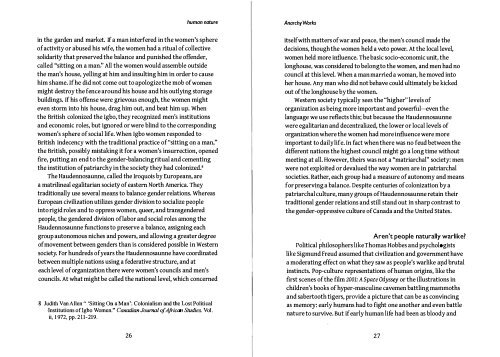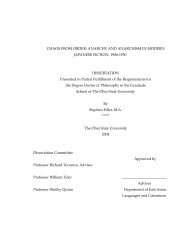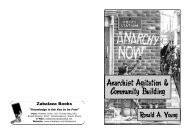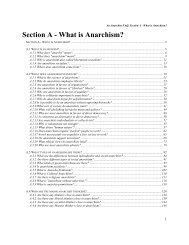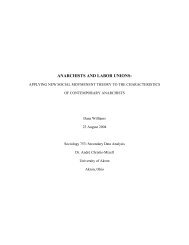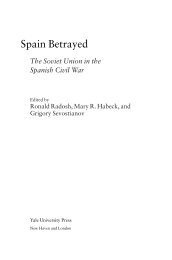Anarchy Works.pdf - Infoshop.org
Anarchy Works.pdf - Infoshop.org
Anarchy Works.pdf - Infoshop.org
Create successful ePaper yourself
Turn your PDF publications into a flip-book with our unique Google optimized e-Paper software.
human nature<br />
<strong>Anarchy</strong> <strong>Works</strong><br />
in the garden and market. If a man interfered in the women's sphere<br />
of activity or abused his wife, the women had a ritual of collective<br />
solidarity that preserved the balance and punished the offender,<br />
called "sitting on a man:' All the women would assemble outside<br />
the man's house, yelling at him and insulting him in order to cause<br />
him shame. If he did not come out to apologize the mob of women<br />
might destroy the fence around his house and his outlying storage<br />
buildings. If his offense were grievous enough, the women might<br />
even storm into his house, drag him out, and beat him up. When<br />
the British colonized the Igbo, they recognized men's institutions<br />
and economic roles, but ignored or were blind to the corresponding<br />
women's sphere of social life. When Igbo women responded to<br />
British indecency with the traditional practice of "sitting on a man,"<br />
the British, possibly mistaking it for a women's insurrection, opened<br />
fire, putting an end to the gender-balancing ritual and cementing<br />
the institution of patriarchy in the society they had colonized.s<br />
The Haudennosaunne, called the Iroquois by Europeans, are<br />
a matrilineal egalitarian society of eastern North America. They<br />
traditionally use several means to balance gender relations. Whereas<br />
European civilization utilizes gender division to socialize people<br />
into rigid roles and to oppress women, queer, and transgendered<br />
people, the gendered division oflabor and social roles among the<br />
Haudennosaunne functions to preserve a balance, assigning each<br />
group autonomous niches and powers, and allowing a greater degree<br />
of movement between genders than is considered possible in Western<br />
society. For hundreds of years the Haudennosaunne have coordinated<br />
between multiple nations using a federative structure, and at<br />
each level of <strong>org</strong>anization there were women's councils and men's<br />
councils. At what might be called the national level, which concerned<br />
8 Judith Van Allen " 'Sitting On a Man'; Colonialism and the Lost Political<br />
"Institutions oflgbo Women." Canadian Journal ofAfrican Studies. Vol.<br />
ii, 1972, pp. 211-219.<br />
itself with matters of war and peace, the men's council made the<br />
decisions, though the women held a veto power. At the local level,<br />
women held more influence. The basic socio-economic unit, the<br />
longhouse, was considered to belong to the women, and men had no<br />
council at this level. When a man married a woman, he moved into<br />
her house. Any man who did not behave could ultimately be kicked<br />
out of the longhouse by the women.<br />
Western society typically sees the "higher" levels of<br />
<strong>org</strong>anization as being more important and powerful-even the<br />
language we use reflects this; but because the Haudennosaunne<br />
were egalitarian and decentralized, the lower or local levels of<br />
<strong>org</strong>anization where the women had more influence were more<br />
important to daily life. In fact when there was no feud between the<br />
different nations the highest council might go a long time without<br />
meeting at all. However, theirs was not a "matriarchal" society: men<br />
were not exploited or devalued the way women are in patriarchal<br />
societies. Rather, each group had a measure of autonomy and means<br />
for preserving a balance. Despite centuries of colonization by a<br />
patriarchal culture, many groups of Haudeunosaunne retain their<br />
traditional gender relations and still stand out in sharp contrast to<br />
the gender-oppressive culture of canada and the United States.<br />
Aren't people naturally warlike?<br />
Political philosophers like Thomas Hobbes and psycholOgists<br />
like Sigmund Freud assumed that civilization and government have<br />
a moderating effect on what they saw as people's warlike and brutal<br />
instincts. pop-culture representations of human origins, like the<br />
first scenes of the film 2001: A Space Odyssey or the illustrations in<br />
children's books of hyper-masculine cavemen battling mammoths<br />
and sabertooth tigers, prOVide a picture that can be as convincing<br />
as memory: early humans had to fight one another and even battle<br />
nature to survive. But if early human life had been as bloody and<br />
26<br />
27


